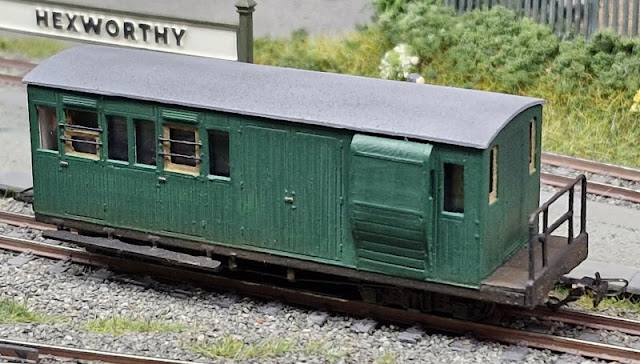Hexworthy has a couple of exhibitions coming up, the first being at Uckfield next weekend. Having done little modelling over the summer, there were a number of jobs I wanted to finish, so the last few weeks have been busy with multiple projects on the go. Starting with a pair of 009 Society kits for Hudson "toast rack" coaches.
The instructions said to add the etched circular rails to the sides before assembly, but I found that made assembly more tricky - especially fitting the benches - and positioning the railings was fiddly anyway. For the second coach, I assembled the body and fitted the bench seats first, adding the etched rails just before adding the seat back rails, fitting the rails was still fiddly but overall it was easier.
I also found fitting the etched steps tricky. It didn't help I bent the first one in the wrong way as the instructions weren't clear, but while on one coach superglue held them in place straight away, on the other they just wouldn't stick in place. I eventually got them fixed on the third attempt, but you can see the mess...
For some reason, one of the coaches started bowing in at the top edge, so I inserted some plasticard supports, but the other seems just fine. With little to the sides they are delicate.
Bogies are the standard WD moulding, but I added the handbrake wheel to the end rather than the upstand (which would foul the end of the coach). The back-to-back of the wheelsets was checked, and my new pinpoint reamer tool used in the axleboxes before inserting the axles to ensure free running.
Another batch of passengers were painted, again a mixture of Preiser HO and the 3D printed Finescale Figures (with no legs) I got a while back. This job is tedious, but at least in the open coaches, noticeable. The Preiser HO figures were used in the toastracks since the lack of legs might look a bit odd, they're a bit small but better than empty coaches.
This coach got painted with enamel (Humbrol 48), not happy with the way it was covering I decided to airbrush the other coach. That said, while not the best paint finish, it's come out looking OK in the end, with a coat of Dullcote. The roof is primer with airbrushed soot, the underframes and step got airbrushed dirt.
This coach got airbrushed with the Tamia deep green as used on the Ashover coaches, but coverage was poor, and it dried shiny. This didn't seem right. I decided to brush on another coat, then realised that the pigment had settled and the pre-airbrush shake hadn't mixed it well as the jar was getting low. So, the finish in the end isn't really any better than the coach above. This got a little more dirt, as though older and due a repaint.
The completed pair, although the coach on the right will match the Ashover coaches while that on the left is a better match for Ffestiniog coaches.
Or, as here, matched with the WHR coach and a small brakevan for a suitable train for a quarry Hunslet - perhaps a private charter or coach party?
Another job was this Dundas kit of Ffestiniog Railway coach no. 10, this I'd made years ago but the green was a bit bright, the windows had turned yellow, and a footboard had got lost. Repainted with Humbrol 48 it is a better match to other FR coaches, a replacement footboard was made up and fitted (can you tell?), and new glazing fitted - I confess I didn't cut to recess the glazing so it's not as flush as it could be. I also noticed the handrails never got fitted, but it may be neater without than with wonky ones. It already had passengers, but I've fitted Greenwich couplings in place of the Microtrains, they're body mounted but this is a short coach and curves on Hexworthy are relaxed so I expect that will be OK.
Another job was the light weathering and fitting of passengers to the Bowsider bogie coach (and also a couple of bug-boxes) acquired recently.
And so a few more coaches are ready for service on Hexworthy, giving more options for train consists and redundancy in case of issues (such as broken couplings). The weekend was spent testing trains, particularly for smooth running and reliable coupling/uncoupling, though that doesn't mean new problems arise during exhibition running!

















































